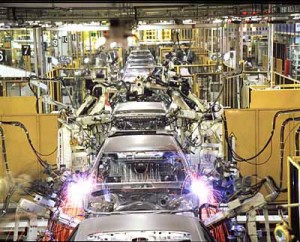
Building a solid relationship with suppliers can be as critical as building the right car, says a new study - which also found that Toyota's supplier relations have been suffering.
Analyst statements that auto production could drop by as much as 30% as part shortages become a huge problem shows that automakers may need to rethink their strategy in choosing suppliers.
IHS Automotive said Thursday that the crisis surrounding the mega earthquake and tsunami that rocked Japan on March 11 could reduce global automotive output by nearly a third or 100,000 vehicles in coming weeks.
The crisis raises some major issues including:
- Should automakers require suppliers to have multiple locations capable of producing critical parts?
- With the Japanese automakers facing the most critical parts shortages, could the crisis reshape the automotive landscape, leading to huge shifts in marketshare?
- Will automakers raise prices as supplies of new cars begin to dwindle?
Predicting automotive supply levels is a true black art, so automakers don’t even know just how many days or weeks they can continue operating before they run out of parts.
Most automakers have a good handle on their tier 1 suppliers and whether they will be able to continue satisfying the contract for parts. But when it comes to tier 2 and tier 3 suppliers – the companies that produce the raw materials or smaller parts that the primary suppliers use – automakers have less knowledge.
Many automakers, even non-Japanese, have already had to halt production at some factories. The reason is Japan produces many sensors and other electronic parts.
For example, Automotive News reported that a Hitachi plant that produces airflow sensors was badly damaged by the quake and tsunami. Hitachi produces 60 percent of the automotive industry’s airflow sensors. The Wall Street Journal reported that Hitachi hopes to restart production by Saturday but doesn’t know how much capacity it can regain.
One solution for crises like the one in Japan would be for companies to require that major suppliers maintain a backup plan, such as a second plant capable of producing key components.
While many automakers struggle to continue production, some may see the catastrophe as an opportunity.
Korea’s automakers believe they may be able to gain as the Japanese automakers deal with the shortages. In fact, Korea’s Yonhap News Agency reported that the country’s largest automakers, Hyundai and its affiliate, Kia, are better insulated from the crisis in Japan because they rely on fewer Japanese parts.
With shortages of any product comes the possibility of increased prices. It’s possible the next several months could be a bad time to be in the market for a new car because supplies could become short.
